
Top 9 Tourist places in Delhi you must visit
Discover Delhi: A Perfect Blend of Heritage and Modern Vibes
Hey fellow travelers! 👋
If there’s one city that effortlessly combines old-world charm with modern glamor, it’s Delhi. This place isn’t just India’s capital—it’s one of the oldest continuously inhabited cities in the world! 🏛️
In this blog, I’m excited to share some of the must-visit tourist places in Delhi, along with my personal itinerary to help you plan your own adventure. And hey, don’t leave without tasting both the luxurious Mughlai cuisine and the mouth-watering, budget-friendly street food. Trust me, your taste buds will thank you! 😋
Whether you’re a history buff, a foodie, or a solo traveler seeking new experiences, Delhi has something special in store for you.
1. Red Fort – A Majestic Marvel You Can’t Miss
Let’s kick things off with one of the most iconic landmarks in Delhi—The Red Fort (Lal Qila).
This UNESCO World Heritage Site is not just a monument; it’s a walk through centuries of royal history. Built by Emperor Shah Jahan in 1638, the Red Fort served as the main residence for Mughal emperors for nearly 200 years.
Why it’s a must-see:
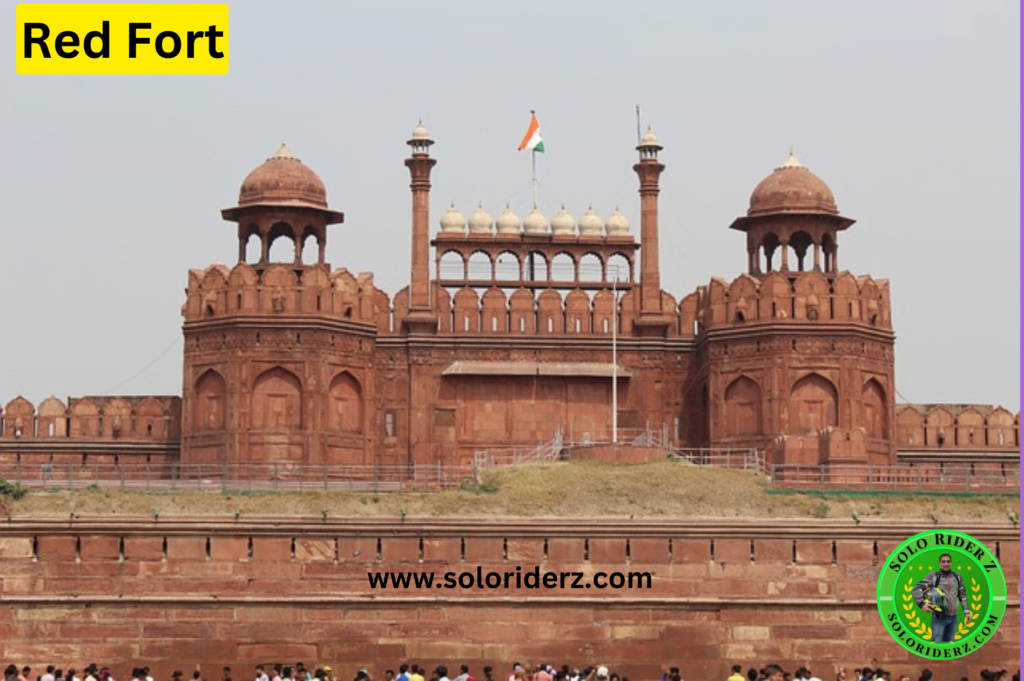
- Its stunning red sandstone walls and grand Mughal architecture will blow your mind.
- Inside, you’ll find marvels like the Diwan-i-Aam (Hall of Public Audience), Diwan-i-Khas (Hall of Private Audience), and Rang Mahal (Palace of Colors)—each telling a story of grandeur and power.
- Don’t miss the Royal Baths (Hammams) and the magical Sound and Light Show in the evening—it’s like history coming to life!
- And yes, this is the same place where the Indian Prime Minister hoists the flag every Independence Day (15th August). 🇮🇳
Quick Info:
- 📍 Location: Netaji Subhash Marg, Chandni Chowk, Delhi
- 🕐 Visiting Hours: Sunrise to sunset
- 🚫 Closed On: Mondays
- 🎟️ Entry Fee: Yes (concessions available for students & seniors)
Tip: Always check the official website before visiting, just in case there are any changes in timings or special events happening.
✨ My Experience
Walking through the Red Fort felt like stepping back in time. As a solo rider, I loved the freedom to explore every corner, take my time with the intricate architecture, and imagine what life must have been like during the Mughal era.
Ready to Explore Delhi?
If you’re planning a trip to India or just curious about Delhi’s rich heritage, this city should be on your bucket list. Keep reading as I dive into more incredible places around Delhi that are perfect for solo travelers and culture lovers alike.
👉 Don’t forget to bookmark this blog and share it with your travel buddies!
And if you’ve been to Delhi before, I’d love to hear about your favorite spots—drop a comment or connect with me on social media!
Stay curious, keep exploring, and ride safe! 🛵✨
2. India Gate – Where Honor Meets Heart
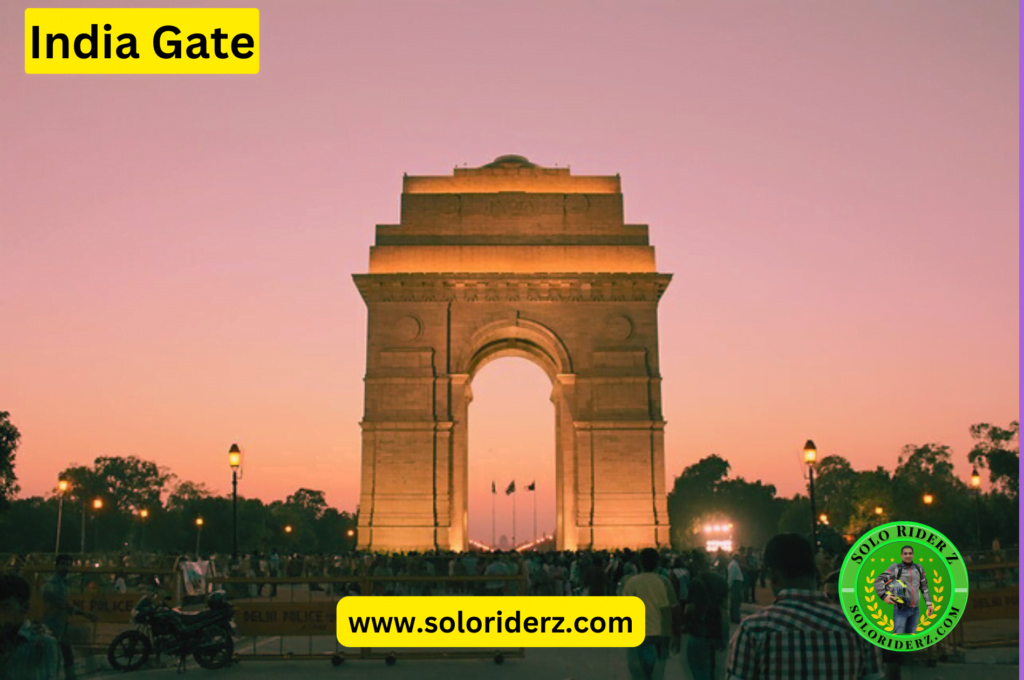
If there’s one place in Delhi that tugs at your heart while giving you the perfect spot to unwind, it’s India Gate. More than just a tourist attraction, India Gate stands tall as a symbol of sacrifice, pride, and unity.
Built in 1931, this majestic war memorial pays tribute to over 70,000 Indian soldiers who lost their lives during World War I. Standing 42 meters tall, right in the heart of New Delhi, it reminds every visitor of the bravery that shaped our nation.
Why You’ll Love Visiting India Gate
🌅 A Peaceful Morning Escape
If you’re a solo traveler like me who enjoys the calm of early mornings, visiting India Gate at dawn is pure magic. The soft morning light, the gentle breeze, and the serene atmosphere—it all just hits different.
🌇 Evening Vibes You Can’t Miss
Now flip the scene to evening, and the entire place transforms! The monument lights up in golden hues, the fountains dance with colors, and there’s a cheerful buzz of people enjoying the moment—families picnicking, couples strolling, kids running around… it’s Delhi at its warmest.
🔥 Amar Jawan Jyoti – The Eternal Flame
Right beneath the grand arch burns the Amar Jawan Jyoti, a flame that never dies. It honors the unknown soldiers, standing as a quiet yet powerful reminder of the courage that protects us every day.
🏛️ War Memorial & Museum
Just a short walk away is the National War Memorial, a beautifully designed tribute to soldiers of post-independence wars. If you’re into history, you’ll love the collection of artifacts, stories, and displays that bring our armed forces’ legacy to life.
🌿 Perfect Spot for Relaxation
Surrounded by sprawling green lawns, India Gate is also a favorite hangout for locals. Whether you’re up for a chill picnic, people-watching, or just want to lie back and soak in the moment, this place is a refreshing break from the city rush.
Quick Info for Your Trip
- 📍 Location: Rajpath, New Delhi
- 🕐 Open: 24×7 (Best time: Evening)
- 🎟️ Entry Fee: None! It’s totally free
- 💡 Tip: Bring a mat or a light jacket if you’re hanging out in the lawns at night—Delhi evenings can surprise you with a breeze!
My Takeaway
Walking around India Gate always gives me goosebumps. There’s something powerful about being in a place that holds so much meaning. Whether I’m riding solo or just taking a breather from city chaos, India Gate grounds me.
So, Are You Ready to Feel the Heartbeat of Delhi?
If you’re in Delhi—even for a day—India Gate should definitely be on your list. Come in the morning for peace, stay in the evening for the vibe, and take a moment to reflect on the sacrifices of those who’ve guarded our freedom.
👉 Like what you read? Hit that share button, save this post, or drop a comment with your thoughts or questions!
Let’s keep this journey going—more incredible spots in Delhi coming up next! 💫
3. Qutub Minar – Towering Glory That Tells a Thousand Stories
If you’re someone who’s fascinated by stories etched in stone and places that whisper centuries-old secrets, then Qutub Minar is your next must-visit stop in Delhi.
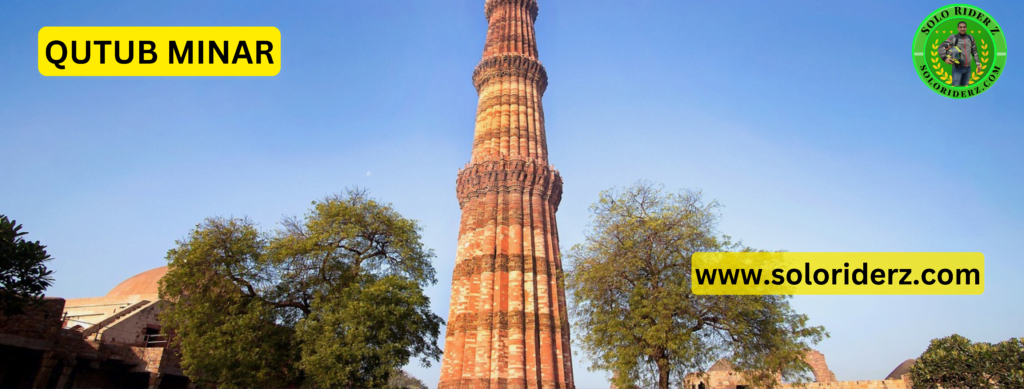
Standing tall at 73 meters, this UNESCO World Heritage Site is not just a monument—it’s a time capsule. Whether you’re into history, architecture, or just love soaking in the atmosphere of ancient places, Qutub Minar will sweep you off your feet (and probably leave your neck sore from looking up so much 😄).
What Makes Qutub Minar So Special?
🏛️ A Victory in Stone
Qutub Minar was started in the early 1200s by Qutub-ud-din Aibak, marking the beginning of Muslim rule in India. It’s not just the tallest brick minaret in the world—it’s a symbol of change, power, and legacy. Every brick speaks of victory and transformation.
🎨 Blended Architecture at Its Finest
What blew my mind was how this structure beautifully merges Hindu craftsmanship with Islamic artistry. The carvings, the Quranic verses, the fluted design—each level of the tower shows the passage of time and cultural fusion that defines Delhi.
🕌 Explore the Qutub Complex
Don’t just stop at the tower—walk around! You’ll stumble upon some real architectural gems like:
- Quwwat-ul-Islam Mosque – One of the oldest in India, built with stones from demolished Hindu temples. The contrast is stunning.
- The Iron Pillar – This 7-meter pillar has stood rust-free for over 1,600 years. Try wrapping your arms around it (there’s a legend attached)!
- Alai Darwaza – A beautiful gateway with Islamic arches and latticework.
- Tomb of Iltutmish – Quiet, intricate, and humbling—it’s the final resting place of one of Delhi’s earliest rulers.
💡 Bonus: Light & Sound Show in the Evening
If you can, stay for the evening light and sound show. Trust me, it adds a whole new dimension to your visit. The lights dancing on ancient walls while the narrator takes you back in time? Pure goosebumps.
Quick Travel Info
- 📍 Location: Mehrauli, South Delhi
- 🕐 Timings: Open daily, sunrise to sunset
- 🎟️ Entry Fee: Yes, for both Indians and foreigners (combo tickets available)
- 📸 Pro Tip: Get there early to beat the crowd—and don’t forget your camera!
My Solo Travel Take
There’s something surreal about standing beside Qutub Minar and realizing how many empires it has witnessed. I sat under a tree in the complex for a while, just soaking in the energy of the place—and believe me, it’s a vibe. 🧘♂️
If you’re on a solo trip through Delhi, Qutub Minar is a place you’ll want to linger. It’s where history meets beauty, and where stories from centuries ago come alive.
Ready to Take a Walk Through Time?
Put Qutub Minar on your itinerary and take a journey into Delhi’s medieval past. Capture it, feel it, and share it with your fellow travel enthusiasts.
👉 Loved this stop? Drop your thoughts below, save this post for later, and keep following along as I uncover more gems across Delhi! Up next—another spot you can’t afford to miss!
Thanks for keeping the momentum going, Sanjay! Here’s your beautifully reworked conversational version of Humayun’s Tomb – Elegance and Serenity, with a warm tone, storytelling flow, and a call to action at the end:
4. Humayun’s Tomb – Where Elegance Meets Peace
If you’re someone who enjoys soaking in history while walking through peaceful gardens, you’re going to love Humayun’s Tomb. Often seen as the architectural grandfather of the Taj Mahal, this magnificent monument is where elegance meets serenity—and trust me, it’s worth every step of your visit.
A Love That Stands the Test of Time
This isn’t just a tomb. It’s a beautiful expression of love and remembrance. Built in the 16th century by Empress Bega Begum for her late husband, Emperor Humayun, this place is a royal resting ground, yes—but more than that, it’s a heartfelt tribute that still echoes through its quiet corridors.
A Glimpse of Mughal Grandeur
As you approach the tomb, you’re greeted by its striking red sandstone exterior, contrasted with touches of white marble that gleam under the sun. The symmetry, the arched doorways, the intricate carvings—every inch of this place whispers stories from the Mughal era. It’s the kind of spot that makes you slow down, take a deep breath, and just feel the past.
Stroll Through the Char Bagh
What really sets this place apart is the garden. The Char Bagh, a traditional Persian-style garden, is divided into four symmetrical parts with water channels running through them. Birds chirping, flowers blooming, and water gently flowing—it’s the perfect escape from Delhi’s hustle and bustle. Grab a bench or lie on the grass; it’s the kind of peaceful you didn’t know you needed.
The Taj Mahal’s Muse
Did you know this very tomb inspired the iconic Taj Mahal? Yep! Emperor Shah Jahan drew ideas from here to build the Taj for Mumtaz. So when you’re here, you’re literally standing in the footsteps of history that shaped one of the world’s wonders.
A Legacy Preserved
Thanks to years of careful restoration, Humayun’s Tomb looks just as majestic today. The gardens have been brought back to life, and the tomb itself has been lovingly preserved, giving all of us a chance to connect with Delhi’s rich past.
Quick Visitor Info:
📍 Location: Nizamuddin East, New Delhi
🕒 Timings: Open daily, from sunrise to sunset
🎟️ Entry Fee: Applicable for both Indian and foreign tourists. Discounts for students and senior citizens available.
Humayun’s Tomb is more than a monument—it’s a serene retreat, a piece of living history, and a photographer’s dream. Whether you’re traveling solo, with family, or just want a quiet corner to reflect, this place has something special for everyone.
So pack your camera, put on those walking shoes, and let the peaceful aura of Humayun’s Tomb take you on a journey through time. Don’t just visit—experience it.
🌸 Lotus Temple – A Symbol of Peace and Unity
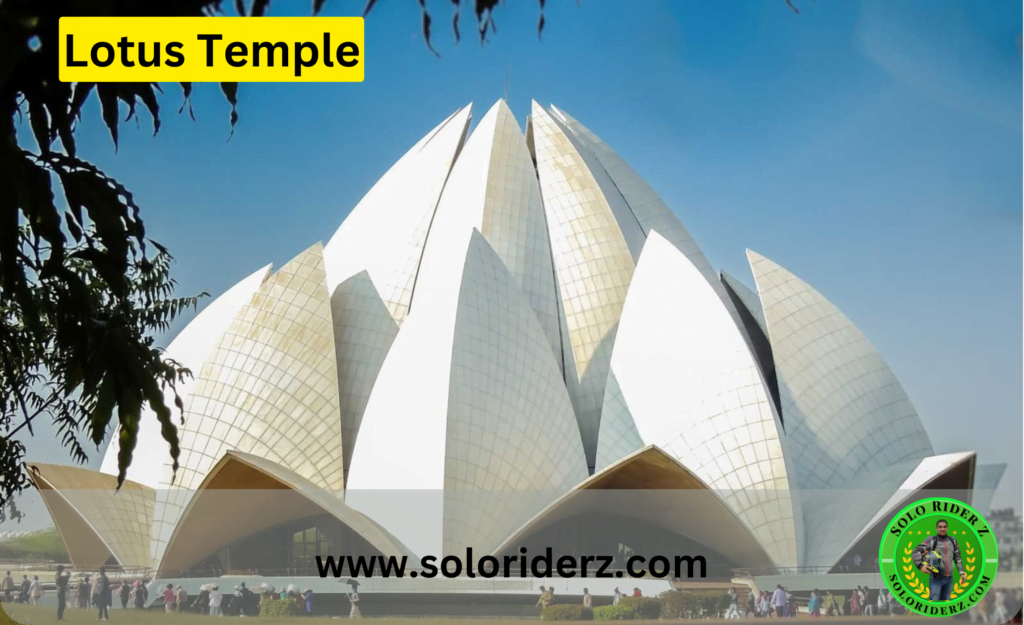
Have you ever seen a building shaped like a blooming lotus? Well, that’s exactly what you get at the Lotus Temple—a peaceful oasis in the heart of Delhi, open to everyone, no matter your faith.
Where Architecture Meets Spirituality
Completed in 1986, this Bahá’í House of Worship is built from pure white marble and shaped like a giant lotus flower, with 27 petals that unfold gracefully. It’s not just beautiful—it’s symbolic. The lotus, rising from muddy waters, reminds us of purity and the unity of all humanity.
A Place for Every Soul
What makes the Lotus Temple truly unique is its open-door policy. No matter what religion you follow—or even if you don’t follow one at all—you’re welcome here. There are no idols, no sermons. Just silence, peace, and an open space for prayer and meditation.
Gardens That Calm the Spirit
As you walk the pathway through lush green lawns, surrounded by flowers and fountains, you can already feel your mind slowing down. The temple’s surroundings are perfect for reflection or simply taking a peaceful stroll away from Delhi’s chaos.
Award-Winning Wonder
The Lotus Temple isn’t just spiritually uplifting—it’s also an architectural marvel. It’s been recognized globally for its innovative, sustainable design. Natural light fills the interiors, and the building breathes without the need for artificial cooling.
Visitor Info:
📍 Location: Near Kalkaji Mandir, South Delhi
🕒 Hours: Open Tuesday to Sunday, 9:00 AM – 7:00 PM (Summer), 9:30 AM – 5:30 PM (Winter)
🎟️ Entry Fee: Free
Take a moment. Close your eyes. Breathe.
That’s the kind of feeling you’ll leave with after visiting the Lotus Temple. If you’re looking to disconnect and find inner calm, this is your spot.
🛕 Akshardham Temple – Where Culture Comes to Life
Akshardham isn’t just a temple. It’s a spiritual theme park and a celebration of Indian culture that will blow your mind. From jaw-dropping carvings to a water show that tells stories with lasers and fountains, it’s a full-on cultural experience.
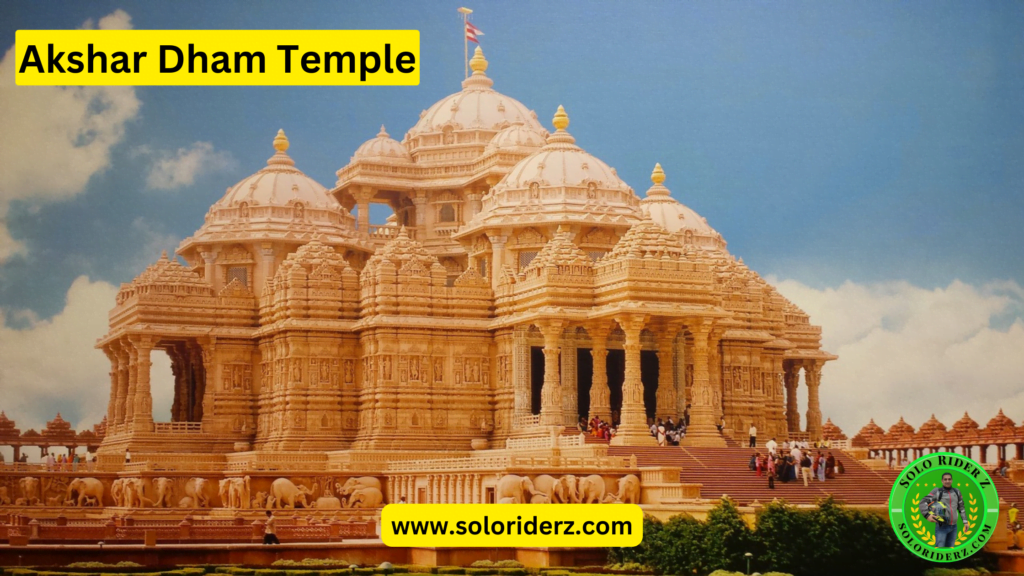
A New-Age Wonder with Ancient Soul
Opened in 2005, Akshardham’s main temple is a stunning mix of pink sandstone and white marble, adorned with over 20,000 sculptures. Every corner tells a story—of gods, legends, and ancient India.
The Divine in Detail
At the heart of the temple is Bhagwan Swaminarayan, whose golden murti shines brightly in the sanctum. The spiritual energy is tangible, even in the grand surroundings.
More Than Just a Temple
- 🛶 Cultural Boat Ride: Float through India’s history in 15 minutes—from ancient universities to inventions that changed the world.
- 💦 Sahaj Anand Water Show: Lasers, fire, music, and storytelling—this is not your average temple show!
- 🌿 Garden Trails: Walk among statues of great Indian thinkers, saints, and heroes.
A Ritual Experience
Don’t miss the Abhishek Mandap, where you can perform a sacred water ritual yourself. It’s an intimate and memorable part of the visit.
Visitor Info:
📍 Location: NH 24, near Noida Mor
🕒 Timings: Tuesday to Sunday (Check official site for updated hours)
🎟️ Entry Fee: Free for the temple, separate charges for exhibitions and shows
📵 Note: No phones or cameras allowed inside
If you’re into culture, spirituality, or just want to see one of the grandest structures in Delhi—Akshardham is a must.
7. 🛍️ Chandni Chowk – Delhi’s Timeless Bazaar
Chandni Chowk is not just a market. It’s a living, breathing piece of old Delhi—buzzing with color, chaos, and charisma. You haven’t really seen Delhi until you’ve gotten lost in these lanes.
Where History and Shopping Collide
Built in the 17th century by Shah Jahan, this place once had a canal reflecting the moonlight—hence the name “Moonlight Square.” Today, it’s a paradise for bargain hunters, history lovers, and foodies.
A Shopper’s Dream
- 🧂 Khari Baoli: Asia’s biggest spice market. Your nose will know you’ve arrived.
- 💍 Dariba Kalan: The bling lane—full of traditional jewelry.
- 🧵 Kinari Bazaar: Fancy trimmings, wedding wear, and vibrant fabrics.
History at Every Turn
On one side stands the majestic Red Fort, and on the other, the towering Jama Masjid. As you shop, you’re literally walking in the shadows of empires.
Street Food Heaven
Feeling hungry? You’re in luck:
- Paranthe Wali Gali – For deep-fried, stuffed flatbreads
- Old Famous Jalebi Wala – For syrupy, golden jalebis
- Kebabs & Chaat – Everywhere, and delicious
Ride Through the Past
Hop on a cycle rickshaw for a ride you’ll never forget. You’ll weave through crowds, havelis, and hidden courtyards with stories tucked into every corner.
Visitor Info:
📍 Location: Old Delhi
🚇 Metro: Chandni Chowk Station (Yellow Line)
🕒 Best Time to Visit: Early mornings or late afternoons for a less-crowded experience
Come for the shopping, stay for the history.
Chandni Chowk is a feast—for the eyes, the taste buds, and the soul. of Delhi’s eclectic spirit.
8. Lodhi Gardens – A Green Oasis in Delhi
If you’re looking to escape the hustle and bustle of the city, Lodhi Gardens is your perfect getaway. This historical park, nestled amidst ancient tombs, lush greenery, and serene water bodies, is the ideal spot for a morning jog, a peaceful walk, or simply unwinding in nature.
A Walk Through History
Spanning over 90 acres, Lodhi Gardens—officially known as the Lodi Gardens or Bagh-i-Jud—is a peaceful haven that showcases the rich heritage of Delhi from the Sayyid and Lodi dynasties of medieval India. The gardens are home to ancient tombs, mosques, and other historic structures dating back to the 15th century, making it a treasure trove of cultural significance.
Architectural Marvels
The Lodhi Gardens are known for their striking Indo-Islamic architecture. As you wander through the park, you’ll encounter several magnificent tombs and mausoleums, each telling a story of the past. Notable landmarks include:
- The Tomb of Sikandar Lodi
- The Shisha Gumbad
- The Bara Gumbad
These historical structures, with their intricate carvings and grandeur, stand as silent storytellers of Delhi’s past, adding to the rich charm of the garden.
A Botanical Haven
Beyond its historical allure, Lodhi Gardens is a botanical paradise. The sprawling lawns, interspersed with serene water bodies and vibrant flower beds, make it an ideal retreat for nature lovers. Whether you’re looking for a spot to relax, have a picnic, or practice yoga, the greenery provides a peaceful setting for it all.
Fitness and Fun for All
Lodhi Gardens is not just about peace and quiet—it’s a hub for recreation and fitness. Early risers can be seen jogging along the tree-lined paths, while fitness enthusiasts practice yoga and exercise routines. The open spaces are also frequently used for community events, cultural performances, and gatherings, making it a lively spot for locals and tourists alike.
Unique Features: Bonsai and Herbal Gardens
Lodhi Gardens also boasts some unique attractions like the Bonsai Park, where you can admire the delicate art of miniature tree cultivation. Another notable feature is the herbal garden, which showcases a variety of medicinal plants, offering a perfect blend of nature and education.
Cultural and Artistic Vibes
The serene surroundings of Lodhi Gardens often serve as the perfect setting for cultural events, including art exhibitions and music concerts. The way history and nature seamlessly blend here creates an ambiance that invites creativity and artistic expression.
Visitor Information:
📍 Location: Lodhi Road, New Delhi
🕒 Timings: Open daily from sunrise to sunset
🚇 Accessibility: Nearest metro station is Jor Bagh
Lodhi Gardens is not just another park; it’s a sanctuary where nature and history come together in perfect harmony. Whether you seek a quiet moment for reflection, wish to explore Delhi’s rich past, or simply want to immerse yourself in lush greenery, Lodhi Gardens is the ideal place. The gentle rustle of leaves, the echo of history, and the tranquility of nature all converge here, offering a unique experience for every visitor.
Would you like to continue with your next destinations, or do you need help with social media posts for these locations, Sanjay?
9. Delhi Haat – A Cultural Kaleidoscope in the Heart of Delhi
If you want to explore the true flavors of India—its art, crafts, and food—all in one place, then Delhi Haat should be at the top of your list. It’s not just a market; it’s an experience that brings together the vibrant essence of India’s diverse states in one beautifully curated space.
A Favorite Weekend Hangout
Delhi Haat is one of the most visited tourist places in Delhi, and even locals from Delhi NCR love to flock here, especially on weekends or during local festivals. The best time to visit is between October and February, when Delhi’s weather is at its most pleasant—perfect for leisurely walks and open-air shopping.
Where is Delhi Haat?
There are three Delhi Haat locations around the city:
- Delhi Haat INA (most popular, located near INA Market)
- Delhi Haat Pitampura
- Delhi Haat Janakpuri
Out of these, Delhi Haat INA remains the most visited and iconic. It’s easily accessible by metro, bus, taxi, or ride-sharing apps like Ola or Uber.
Nearest Metro Station: INA
Nearest Bus Stop: INA Market
What Makes Delhi Haat So Special?
The charm of Delhi Haat lies in its representation of India’s rich cultural heritage. Each state of India has its own dedicated stall, where artisans showcase handcrafted items such as:
- Jewelry
- Metal artifacts
- Traditional garments
- Handicrafts
- Paintings and home décor
It’s the perfect place to shop for souvenirs or support local artisans directly.
A Foodie’s Paradise
Feeling hungry after shopping? Delhi Haat has you covered! You’ll find food stalls from every Indian state, serving authentic regional delicacies—from Rajasthani thali and Bengali sweets to Nagaland smoked pork and Kashmiri kebabs. It’s like a food festival that never ends!
Visiting Hours and Entry Fee
🕙 Timings: Open daily from 10:00 AM to 10:00 PM
🎫 Entry Fee (may vary; check the official website for updates):
- Adults: ₹30
- Children: ₹20
- Foreigners: ₹100
(These were the prices during my last visit, but they might have changed.)
Why Visit Delhi Haat?
Delhi Haat is more than just a market—it’s a celebration of India’s unity in diversity. Whether you’re a traveler seeking authentic local crafts, a food lover exploring regional cuisines, or someone just looking for a chill evening out, Delhi Haat offers something for everyone.
So the next time you’re in Delhi, don’t miss this cultural gem. And if you’re already in the city, make a weekend plan—trust me, you’ll leave with a happy heart and probably a bag full of handmade treasures!
Would you like me to turn this into a social media caption or post for Instagram, Facebook, or LinkedIn as well, Sanjay?
useful website
- Delhi tourism website
- Akshardham official website
- Lotus Temple official website for information
- Qutub Minar official information
- Delhi Haat official website for information
Coclusion : Tourist Places in Delhi – A City of Wonders
Delhi, with its myriad tourist destinations, has something for every traveler. Whether you are a history buff, a culture enthusiast, a nature lover, or a shopaholic, Delhi promises an unforgettable experience. The city’s ability to preserve its ancient heritage while embracing modernity makes it a kaleidoscope of colors, flavors, and experiences. You may visit the official website of Delhi Tourism here.
The historical monuments of Delhi will charm you with its history. Plan your trip during winter to discover the stories etched in stone, also do taste the flavors of Delhi’s versatile cuisine, and immerse yourself in the vivacity of this extraordinary city. I am sure you are ready to leave an indelible mark on your heart and soul.
Frequently Asked Questions about Tourist Places in Delhi
Q1: What are the top historical monuments to visit in Delhi?
A1: Delhi boasts an array of historical monuments that showcase its rich past. Some must-visit ones include the Red Fort, Qutub Minar, Humayun’s Tomb, and India Gate.
Q2: How do I get to these tourist destinations in Delhi?
A2: Delhi has a well-connected public transportation system. You can easily reach these tourist destinations by using the Delhi Metro, local buses, auto-rickshaws, and taxis.
Q3: Is the Red Fort open every day, and what are the visiting hours?
A3: Yes, the Red Fort is open to visitors every day except on Mondays. The visiting hours are from 9:30 AM to 4:30 PM. However, it’s advisable to check for any updates or changes in timing before planning your visit.
Q4: Are there any entry fees for visiting these monuments?
A4: Yes, most of the historical monuments in Delhi have entry fees for Indian and foreign tourists. The fees are generally nominal, and there might be additional charges for photography and videography.
Q5: Can I hire a guide to explore these tourist destinations?
A5: Yes, hiring a local guide is an excellent idea, especially if you want to delve deeper into the historical and cultural significance of these places. Guides are available at the entrance of most monuments.
Q6: What are the best times to visit these tourist destinations in Delhi?
A6: The best time to visit these tourist destinations is during the winter months, from October to March when the weather is pleasant and suitable for sightseeing.
Q7: Are these tourist destinations accessible for differently-abled individuals?
A7: Efforts have been made to improve accessibility at many tourist destinations in Delhi. However, not all monuments might be fully wheelchair-friendly. It’s advisable to check with the specific destination’s website or contact authorities for detailed accessibility information.
Q8: Is photography allowed inside these historical monuments?
A8: Yes, photography is generally allowed inside most of these monuments. However, there might be restrictions on using flash or tripods. It’s essential to check the guidelines and rules at each location.
Q9: Are there any dress code requirements for visiting religious places like the Lotus Temple?
A9: Yes, when visiting religious places like the Lotus Temple, it’s advisable to dress modestly. Avoid wearing sleeveless tops, shorts, or revealing clothing.
Q10: Can I carry food and water inside these tourist destinations?
A10: It’s best to avoid carrying food inside historical monuments, as it may not be allowed. However, water bottles are generally allowed, and many places have drinking water facilities available.
Wrap up!
So, embark your journey to Delhi, and let its magical charm sweep you off your feet. Discover the stories etched in stone, savor the flavors of its cuisine, and immerse yourself in the vivacity of this extraordinary city. Delhi awaits, ready to leave an indelible mark on your heart and soul.
You may also like to read more about
A 5-day itinerary will definitely help you in planning your successful trip
first of all, I’m sharing with you my itinerary which I prepared for myself during my 5-day tour to Delhi.
| Day | Morning | Afternoon | Evening |
|---|---|---|---|
| Day 1 | – Arrival in Delhi | – Visit India Gate | – Explore Connaught Place |
| – Check-in to hotel | – Explore Rashtrapati Bhavan | – Dinner at a local eatery | |
| Day 2 | – Visit Red Fort | – Explore Jama Masjid | – Enjoy street food at Chandni Chowk |
| – Explore Raj Ghat | – Shop at Dilli Haat | – Relax at India Gate | |
| Day 3 | – Explore Qutub Minar | – Visit Humayun’s Tomb | – Explore Lotus Temple |
| – Lunch at a local restaurant | – Visit Akshardham Temple | – Evening at India Gate | |
| Day 4 | – Explore National Museum | – Visit Lodhi Gardens | – Shopping at Sarojini Nagar |
| – Visit India Habitat Centre | – Explore Hauz Khas Village | – Dinner at a rooftop restaurant | |
| Day 5 | – Visit Gandhi Smriti | – Explore National Handicrafts Museum | – Farewell dinner at a fine dining restaurant |
| – Explore Dilli Haat | – Shop for souvenirs |
Please note that this Itinerary I prepared during my solo travel to Delhi. This may help you as a guide to prepare your own itinerary based on your interests and the opening hours of the attractions. Delhi has a lot to offer, so make sure to explore its rich history, culture, and cuisine during your visit!




